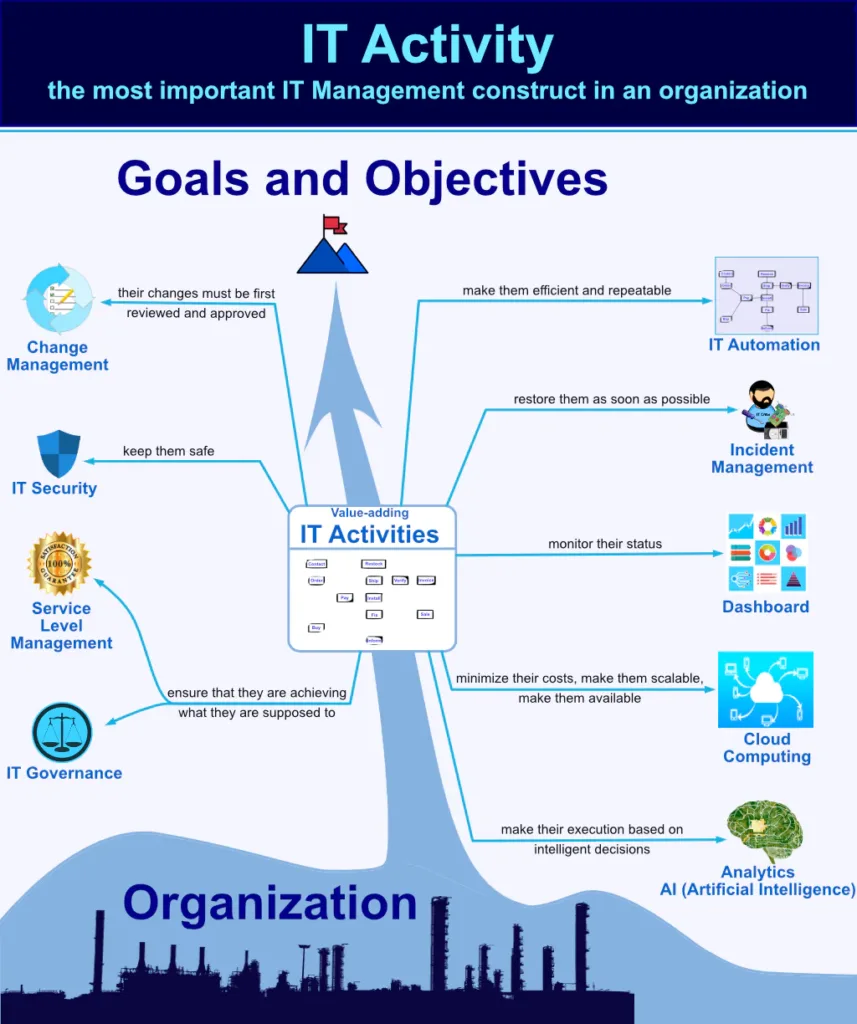This is the first blog in the series of “IT Automation – standardize it!”, trying to create a categorization that would serve people and organizations concerned with an end-to-end holistic approach to IT Automation.
The main point that I’m making here is that an organization that seeks to gain a distinctive strategic advantage on their market will:
- Have to recognize the end-to-end automation as their primary vehicle of delivering value
- Need to use more generalized terms that are suitable for representing their enterprise-wide automation solution at the architecture level
If you are concerned with end-to-end enterprise or business architecture and with increasing your organizational value beyond the business domain norms, please read further.
Introducing IT Activity
In the day-to-day of organizational life, we are calling them sales, requisitions, deliveries, orders, tickets, etc. These are examples of organizational activities that add value to the business. These are what organizations are doing to achieve their goals and objectives.
Today, most of organizational activities are carried out by computer systems; these are IT Activities.
IT Activity is the central construct in IT Management
The value-adding IT Activities are the central piece of IT Management.
Executing them and achieving their expected results is the essential reason the other IT Management domains and disciplines exist.
Let’s probe the validity of this claim.
An organization has goals and objectives, so they are executing value-add human and IT activities to accomplish them. Then the organization wants its IT Activities to:
- Run efficiently è IT Automation
- Deliver what they are set to è IT Governance, IT Service Level Management
- Be defended and safe è IT Security
- Be observed and measured and their progress status visible è Dashboarding, Reporting
- Be repaired and restored if they get interrupted or failing è Incident Management
- Be protected from unapproved changes è Change Management
- Use intelligent decisions è Analytics, AI (Artificial Intelligence)
- Be always available for execution in case of catastrophic events è IT Business Continuity
- Scale their execution capabilities with the business seasonality (or with the organization’s progressive growth), to minimize their costs, to increase availability, etc. è Cloud

Moreover, not all IT domains that are surrounding and are supporting value-add IT Activities, are adding value to organizations:
- Some are increasing the organizations’ costs, without adding business value, such as Security, Governance, Service Level Management, IT Business Continuity, Change Management
- Some are contributing to avoid or minimize costs, such as Cloud, IT Incident Management
The IT Management domains that are contributing to add business value are IT Automation, Analytics, and AI, and they are all achieving that through IT Activities.
If the term IT Activity is so important, why is it not in the spotlight of the IT Management knowledge domain?
- Most of the organizational problems that need to be addressed are not crossing their functional or departmental domains.
In these narrowly concerned situations, using the term IT Activity is not suitable, but it is recommended to use the most specific language that describes the problem and its solution. For example, if the problem that needs a solution involves mainly people that are responsible for the service desk domain, the IT Activities involved should be specifically named using, for example, opening, resolving, and escalating tickets.
- There are few organizations that are concerning themselves, yet, with holistic automation.
Or, for the ones that are, the lack of IT Automation standardization, which I’m trying to address in the ”Standardize it!” blog series, is a significant impediment.
But do we really need a generalized term such as IT Activity?
We would need to use generalized terms, such as IT Activities, when we would look into addressing organization-wide problems.
So the question turns into, what could be the organization-wide problems that would need resolving, and which would involve the use of generalized high-level terms?
1. High-performing organizations need, as a next initiative, to gain a holistic end-to-end understanding and control of their activities to keep their strategic market advantage.
Agility and adaptivity will become less impacting as contributer towards organizational strategic advantage, like any other strategic advantage, until now, especially for the organizations competing at the top of their market segment.
These high-performing organizations will have to look into new sources for gaining a strategic advantage; they will have to look into how to do things better, faster, cheaper, addressing their bottom- and top-line concerns. They will have to recognize the importance of generalized IT Automation, and its main subject, IT Activity.
2. AI is going through renascence, it is at the forefront of technological discussions and investments, and it is mainly about using insights to take decisions, to execute activities!
The existing systems and applications already have local specialized decision mechanisms. AI will be of high importance for narrowly oriented problem solving by providing better solutions, intelligent solutions. This use of AI will help to create better “mouse traps”.
However, the real value of AI will be materialized where logical reasoning is needed, in the domain of decision making.
At the end of an AI-based decision is almost always going to be an IT Activity to be carried.
The AI-based decisions will be required in prioritizing the execution of IT Activities and their shared resources by considering their value-adding impact towards the organizations’ goals and objectives, and the costs involved.
Again, for resolving broad problems, the discussion and enterprise solution modeling will require using generalized terminology, and these are the situations when the use of IT Activities, instead of specific activity names, will make sense.
But the IT Management knowledge base is using extensively today IT Services as a central generic term for IT-related activities. Isn’t the use of IT Services generic enough?
IT Services is a narrower term than IT Activities, and it is beneficial in the discussions where IT Services is the proper granular level of analysis and discussion. But while all IT Services are IT Activities, the inverse is not valid. There are many IT Activities involved in the making, deployment, and delivery/execution of an IT Service that they are relevant in an enterprise architectural analysis, and which not raising to the importance or meaning of an IT Service.
There is already a rational definition and broadly accepted for IT Services. Let’s not remap a well dedicated term to something else; it would confuse the audience, and it will require rewriting a whole existing knowledge domain.
In this blog, I made the case that high-performing organization will have to look into value-increasing solutions based on holistic IT Automation, and this will require the use of higher-level constructs, such as IT Activity, when defining problems and solutions at the enterprise-architecture level.
If you agree with the information I have provided in this blog, please share it, as there might be other people that might be interested to read it.
If you have any opinions, or you can help to improve the information to standardize the IT Automation, please contribute with comments.
In the next blog from this ”IT Automation – standardize it!” series, I’ll dive in and provide detailed IT Activity characteristics and categorizations that will be relevant when broadening the discussion into IT Automation.



